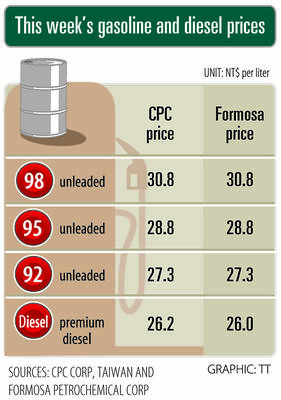Things looked bleak for China's bicycle makers as the pedaling masses fell in love with the car.
But after watching sales slump as anyone who could afford it switched to scooters or sedans, makers have bounced back by targeting export markets that they once ignored and improving the quality of bikes that used to come in just one color -- black -- and one speed.
"China is all about good prices, but quality is also improving very quickly," said Zhang Lei, vice manager for bicycle sales at Suzhou Everich Import & Export Co (蘇州恆豐進出口公司), at a recent trade show in Shanghai.
Zhang and his colleagues were showing off their latest product, the Gold Arrow e-scooter -- an electric three-wheeler that Zhang says can run for up to 25km on one charge.
Also at the show, manufacturers displayed bikes with convex seats and "Harley Davidson" low-rider handlebars and front wheels, chainless bikes, electric bikes, Tonino Lamborghini racing bikes and children's bikes and trikes of every hue and theme, outfitted with Hello Kitty bells, airplane-shaped lights -- you name it.
Chinese own about 450 million bicycles and every year the country produces another 75 million.
More than two-thirds of those are exported, to South America, the Middle East, Europe and the US.
More than nine in 10 bikes bought by Americans are made in China.
The northeastern city of Tianjin, home to the Flying Pigeon brand, exported nearly 8 million bicycles last year, up 35.4 percent over 2003, and aims to boost that to 10 million by next year, according to state media.
Chinese still rely on bicycles to get around crowded cities. The sight of bikes loaded with appliances or mountains of plastic jugs and cardboard due for recycling is common even in Shanghai. Itinerant bike repairmen can be found on almost every street.
But the country came late to the global market. As late as 2000, makers were struggling and inventories soaring as families switched from their trusty, often rusty, Forevers and Flying Pigeons to diesel-powered motorscooters and cars.
In the past few years an influx of foreign investment, retooling by traditional bike makers and the development of a huge market in diverse accessories has breathed new life into the industry, as manufacturers and buyers shifted from Taiwan and Japan to lower-cost China.
"Bikes made in Taiwan got to be just too expensive, so we began making bikes in Shanghai and exporting them to Japan," said Daisuke Iwazu, an employee of Shanghai Hachisuka Bicycle Co, struggling to be heard over a Sesame Street video playing atop his company's display.
Hachisuka, based in central Japan's Aichi prefecture, switched from buying bikes in Taiwan for sale in Japan to making them itself. It now turns out 160,000 units a year and plans to begin sales in China later this year, Iwazu said.
"We're already making bikes here. It would be a waste not to sell here, too," he said.
Taiwan's bicycle exports have been falling since 1999, dropping to about 4.5 million bikes in 2003 from a peak of more than 10 million in the mid-1980s.
Unable to match the low prices of producers in China, where a decent new bike can cost as little as 300 yuan (US$35), Taiwanese companies have been shifting to higher-end bikes, such as one model with a drive shaft instead of a chain.
BikeValley, a South Korean company, was showing TaRa chainless bikes powered by a drive shaft -- a device the company says was invented by its founder, Hwang Chil-sung.
New technology alone may not be enough. Chinese companies also are innovating as they try to stay ahead of Vietnam, another destination for companies looking to cut production costs.
Next to BikeValley's exhibit was one by Adura bikes, a company based in nearby Jiangsu province that sells two-shaft chainless models. And in another hall, a company based in southeast China's Fujian was displaying chainless bikes with pedals attached directly to the rear wheel.
"Folding bikes are what people want," said Samuel Chow, who was manning Adura's booth. "And for folding bikes, this is much better, much cleaner."

Taiwan Semiconductor Manufacturing Co (TSMC, 台積電), the world’s biggest contract chipmaker, booked its first-ever profit from its Arizona subsidiary in the first half of this year, four years after operations began, a company financial statement showed. Wholly owned by TSMC, the Arizona unit contributed NT$4.52 billion (US$150.1 million) in net profit, compared with a loss of NT$4.34 billion a year earlier, the statement showed. The company attributed the turnaround to strong market demand and high factory utilization. The Arizona unit counts Apple Inc, Nvidia Corp and Advanced Micro Devices Inc among its major customers. The firm’s first fab in Arizona began high-volume production

VOTE OF CONFIDENCE: The Japanese company is adding Intel to an investment portfolio that includes artificial intelligence linchpins Nvidia Corp and TSMC Softbank Group Corp agreed to buy US$2 billion of Intel Corp stock, a surprise deal to shore up a struggling US name while boosting its own chip ambitions. The Japanese company, which is adding Intel to an investment portfolio that includes artificial intelligence (AI) linchpins Nvidia Corp and Taiwan Semiconductor Manufacturing Co (TSMC, 台積電), is to pay US$23 a share — a small discount to Intel’s last close. Shares of the US chipmaker, which would issue new stock to Softbank, surged more than 5 percent in after-hours trading. Softbank’s stock fell as much as 5.4 percent on Tuesday in Tokyo, its

The prices of gasoline and diesel at domestic fuel stations are to rise NT$0.1 and NT$0.4 per liter this week respectively, after international crude oil prices rose last week, CPC Corp, Taiwan (台灣中油) and Formosa Petrochemical Corp (台塑石化) announced yesterday. Effective today, gasoline prices at CPC and Formosa stations are to rise to NT$27.3, NT$28.8 and NT$30.8 per liter for 92, 95 and 98-octane unleaded gasoline respectively, the companies said in separate statements. The price of premium diesel is to rise to NT$26.2 per liter at CPC stations and NT$26 at Formosa pumps, they said. The announcements came after international crude oil prices

SETBACK: Apple’s India iPhone push has been disrupted after Foxconn recalled hundreds of Chinese engineers, amid Beijing’s attempts to curb tech transfers Apple Inc assembly partner Hon Hai Precision Industry Co (鴻海精密), also known internationally as Foxconn Technology Group (富士康科技集團), has recalled about 300 Chinese engineers from a factory in India, the latest setback for the iPhone maker’s push to rapidly expand in the country. The extraction of Chinese workers from the factory of Yuzhan Technology (India) Private Ltd, a Hon Hai component unit, in southern Tamil Nadu state, is the second such move in a few months. The company has started flying in Taiwanese engineers to replace staff leaving, people familiar with the matter said, asking not to be named, as the